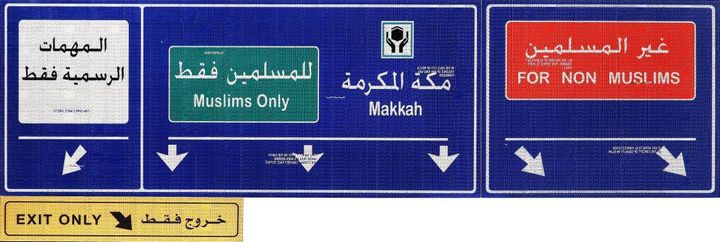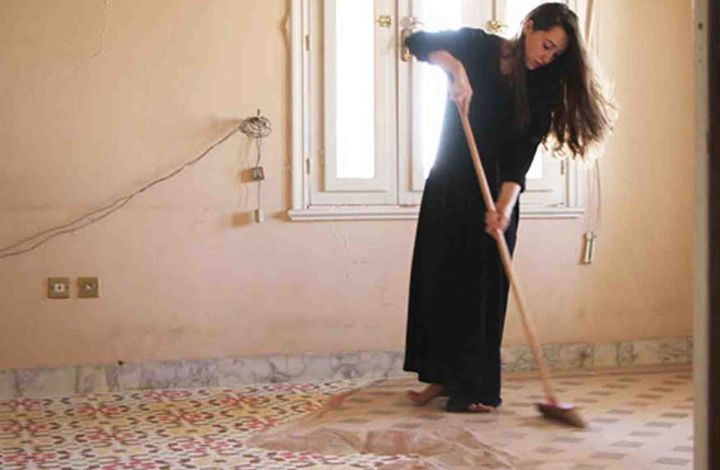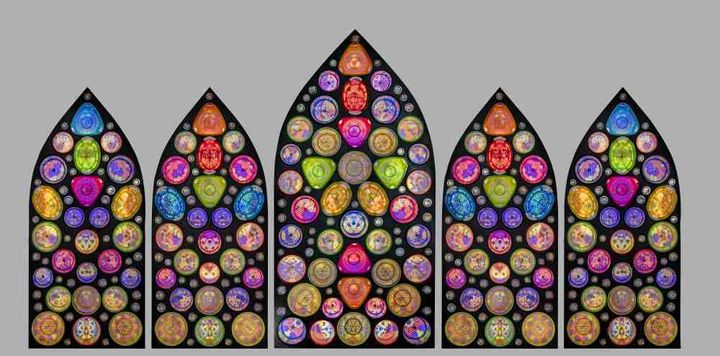On Friday, August 25, the Utah Museum of Contemporary Art at Salt Lake City’s Temple Square opens an exhibition of around 20 artists of Saudi background and descent. “Cities of Conviction,” in its statement by curator Jared Steffensen, asserts that Saudi Arabia and Utah — in their cities of pilgrimage, in their natural landscapes, in their “conservative” religious traditions, and in their shared concerns over materialistic incursions into holy places — have tremendous similarities. The exhibition’s hope is that in encountering the creative work of young Saudi artists, Utahns and Latter-day Saints will be able to learn from how Saudis have addressed a set of “complex issues” that relate to both places and societies.
Yet, the exhibition, in confronting Saudi art at all, necessarily delves into issues of fundamental significance about individual artistic expression in connection to spiritual revelation (wahy) — that perhaps Latter-day Saints could even help Saudis translate to their home country and to the world. What does it signify that a generation of young Saudis has decided to use supposedly “new” creative forms to express their desires, dreams, and frustrations? What does it mean that powerful Saudi institutions, like the brand-new King Abdulaziz Center for World Culture (ithra), are comfortable enough with this artistic movement to sponsor such a thought-provoking exhibition in Salt Lake City? What do these artists want to tell Utahns, and Latter-day Saints, in particular?
While we must be careful not to assume this art represents the views of anyone other than its creators, I think we can appreciate that contemporary Saudi art as a phenomenon is an important signal of the dreams and desires of many young Saudis. Yet, if there is a single theme to be found across this exhibition, it is that this artistic movement does not frame itself as something “new” or “radical.” The movement does not represent a rejection of tradition, a desire to embrace the West uncritically, or a desire to abandon Islam. On the contrary, the works in this exhibition seem rooted in reverence for Allah and belief in Islam. The artists offer their criticisms of Saudi society in the context of active spiritual strivings toward love, equality, and godliness (al-rabbaniyyah). Many pieces are grounded in the traditional creative languages of Arabic calligraphy and geometric pattern. A shared theme throughout the exhibition is of how out-of-control materialism — manifested in hedonistic markers of luxury, the monolithic petroleum industry, and the commodification of Middle Eastern culture in rugs or in food traditions — interferes with spiritual development.
The implicit declaration of a number of these artists seems to be that proper fidelity to tradition lies in pursuing internal spiritual work, especially prayer, and not in following external, carnal forms. Under this understanding, a society could be authentic to tradition, and still become more tolerant toward varying forms of practice and toward deviating individual expressions of revelation or textual reasoning that bring an artist, or any individual, into line with their personal perception of God’s will.
The exhibition’s relevance for Latter-day Saints is much deeper than a new twist on the debate over whether the City Creek Center shopping mall is an imposition on the holiness of Temple Square (in comparison to the rapid, dramatic construction in Mecca). The key connection emerges in appreciating that both Latter-day Saints and Muslims of the Salafi movement (sometimes called Wahhabist after the religious leader Muhammad ibn Abd al-Wahhab) embrace a doctrine of emulating people and practices of the past. Latter-day Saints participate in the restoration of the true Church of Jesus Christ. Salafi Muslims seek to emulate Muhammad and his earliest followers. Both religious movements emerged out of deep disgust for the injustices of powerful, established orders and for innovations of apostasy/heresy/bi’dah that corrupted simple rituals and pure religious practice. The religious-ideological alliance of Muhammad ibn Abd-al Wahhab and Muhammad bin Saud in 1744 led to the dramatic growth of the first Saudi state in the late 18th and early 19th centuries. The formation of the Church of Christ by a small group in New York State in 1829 set in train a series of dramatic events that eventually led to a great migration and the establishment of a new religious-political entity in Utah, initially outside of U.S. government authority. Paradoxically, in both cases, in “restoring” great mass “authorities” onto the Earth, the individual’s spiritual expression — here and now — returned to the center of doctrinal attention.
Latter-day Saints, under the Prophet Joseph Smith and through the revealed translation and dissemination of The Book of Mormon, have undertaken ambitious projects of individual revelation which continue to this day, including during the pilgrimages to the General Conference in Salt Lake City. All Latter-day Saints are encouraged to seek revelation, to study the Holy Scriptures on their own, and to submit their decisions to the scrutiny of the Holy Ghost.
Even though the highest form of revelation, especially of the law, is believed to have ended with the Prophet Muhammad, Muhammad ibn Abd al-Wahhab taught Muslims to read and study the Quran and the hadith (the sayings of the Prophet) themselves, and to seek lesser revelation in order to understand how to obey the commandments identified. Under Salafi conceptions, ambiguities in the application of sharia law are subject to ijtihad, independent reasoning rooted in the study of revealed texts. There is an understanding that cultural circumstances will evolve and new questions necessitating Quranic review will arise.
Restoration does not mean returning to 33 A.D. or the year 1844 (the year of the death of Joseph Smith). Emulation of the al-salaf al-salih, or “pious forefathers,” does not mean returning to 632 or the year 1792 (the year of the death of Muhammad ibn Abd al-Wahhab). Both religious practices promote continual study of revealed texts in order to understand our commandments in the place we are now, and to establish an authentic connection to God. Whether or not we can actually “know” God — a difference between the two doctrines of divinity — both practices pursue revelation that prompts divinely-inspired actions and expressions.

Abdullah Al-Othman, Suspended
In one work in the exhibition, Suspended, Abdullah Al-Othman presents a video of his artistic act of covering a historic building in the old city of Jeddah, Saudi Arabia in tin foil. Abdullah sought to demonstrate the “absurdity” of thinking that “the cycle of change could ever be stopped.” Even if we were to look at this encased form of the past, we would actually only see the reflection of ourselves, enhanced by the holy light of Allah (al-noor, a name of God) that will prompt “new thinking” and “new emotions.” If God’s light is always present and available to us, we don’t need to reach for what Abdullah calls an impossible and false “frozen state.” Instead, we can understand ourselves in the present through the holy reflection of the past. This is a powerful metaphor for understanding the processes of restoration and of emulating the forefathers of Islam.

Abdulnasser Gharem, Road to Makkah (2014)
Other pieces in the exhibition advance societal criticism, rooted in a highly individualized spiritual practice. Through an imagined sign on the highway to Mecca that prompts an individual choice (connecting to LDS doctrine on responsibility and agency), Abdulnasser Gharem offers a satirical take on exclusionary practices of the city, showing how they might be in contradiction with claimed “unity, peacefulness, and sanctity.”
Connecting with the LDS focus on constant spiritual commitment (holding fast to the “iron rod”), Musaed Al Hulis and Nasser Al Salem offer works that address the urgent, determined need to follow the true and straight spiritual path, using modern technological metaphors of bicycle chains and EKG heartbeats to present new perspectives. In alignment with fears of materialism in Utah Mormon culture, Ahmed Mater and Khalid Zatar consider the spiritual implications and societal dangers of total economic reliance on petroleum. In another performative piece that shows her sweeping away tiles of Islamic patterns made of sand, Dana Awartani expresses fears of “modern day destruction of … cultural identity and heritage,” fears that Utah Latter-day Saints can identify with as demographics change and as new societal forces challenge traditionally-understood cultural forms.

Dana Awartani’s I Went Away and Forgot You
An overall message of this exhibition is that in Saudi Arabia, assumed to be one of the most “traditional” societies on Earth, artists are recognizing that a pure alignment with tradition can never be measured in the strict repetition of forms and symbols. In addition to playing with forms of aesthetics, creative artists can resurrect, redefine, and modify the forms of religious practice — and sometimes even discard them — helping societies transition to newly-constituted communities and to new eras. The processes of emulation and restoration do not require an obsessive commitment to past, carnal forms; they only require a sustained commitment to spiritual revelation and textual study as individuals.

Rashed al Shashai’s Heaven’s Door
In one of the signature pieces of the exhibition, Rashed Al Shashai’s Heaven’s Door, we start to see how external, elaborate forms of religion can be misleading. In what seems to be traditional religious iconography of stained glass or Islamic arches, we see, after looking closer, that the piece is actually constructed of everyday objects of plastic kitchenware — corianders and baskets — that Rashed has arrayed. He desires to show how the external forms of religious practices and architectural symbols begin to invade everyday life, giving an “artificial religious veneer” to the injustices and immoralities of our commonplace world and society. Unless I am misunderstanding the artist, the solution, then, is not to abandon religion, but to put our faith and trust in God and not in the external forms of religion, which can be deceptive and manipulative.
Through Arab-American writer Amin al-Rihani’s encounter and great friendship with Saudi King Abdul-Aziz, Rihani came to believe that the American and Protestant experiences could inform our understanding of the Saudi trajectory, clearly so important to the history of the modern world. If Abd al-Wahhab was the Luther of Arabia, perhaps the “restoration” of the Saudi Kingdom in 1932 can be compared to the divine foundation of the American Revolution. The so-called “fanatical” Ikhwan warriors might be matched by the fanatical Puritans, the colonial revolutionaries, or even the early Mormons. Fanaticism has its necessary purpose if freedom must be achieved. Eventually, with the consolidation of its Kingdom, Saudi Arabia, like the America of Puritanism and the Great Awakenings, will transform itself into a society that is generally tolerant of cultural and religious difference and of individual expression. Its inherent valuation of individual revelation and textual study may help it achieve this.
It seems to me that these artists — now even supported by the national oil company Saudi Aramco — are a manifestation of this emerging tolerant future. Americans, but especially Latter-day Saints and Utahns, can help interpret and disseminate these implicit spiritual desires of their artwork. Latter-day Saints, with their focus on individual revelation and with similar dilemmas related to societal change, should be inspired by this exhibition, which will hopefully prompt a great dialogue.
The opening reception will take place at UMOCA on Friday, August 25 from 7 to 9 p.m. Participating artists Yusef Alamahad, Rashed Al Shashai, Nugamshi, Moath Alofi, and Balquis AlRashed will be in attendance. Other featured artists include: Abdullah Al-Othman, Abdulnasser Gharem, Ahmed Mater, Arwa Alneami, Dana Awartani, Ghada Al Rabea, Khalid Bin Afif, Khalid Zahid, Lina Gazzaz, Masameer / Telfaz, Musaed Al Hulis, Nasser Al Salem, Nouf Alhimiary, and Qamar Abdulmalik. A panel discussion will also take place on Saturday, August 26, 2017 from 5 to 6:30 p.m.
Cities of Conviction was created in partnership with the King Abdulaziz Center for World Culture and CULTURUNNERS, co-authored by Stephen Stapleton. While the artworks were curated by UMOCA, the exhibition is part of a ten-city cultural tour by CULTURUNNERS.
